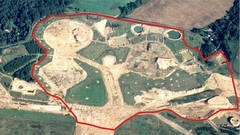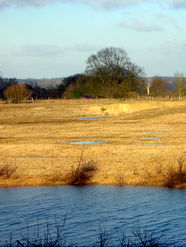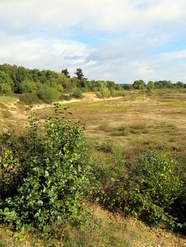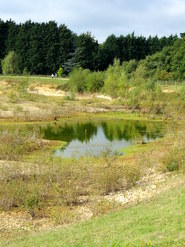
This 31 ha area once contained buildings and concrete pans of the former airbase which were removed in 2000 to 2001, along with around 1 million tonnes of gravel. The area was re-landscaped leaving a variety of landforms including a couple of steep sided, south-facing slopes. Livestock graze throughout the compartment. There is no division into subcompartments.
The water table in the re-landscaped area fluctuates greatly, so the network of large and small ponds varies seasonally in both area and depth. Most are therefore seasonal (ephemeral), with only some of the deeper ones retaining water throughout the year. The ponds are at varying stages of colonisation by vegetation but most are (2014) at an early stage of succession. One pond in the northeast of the area is more developed.
The majority of the area is included in the ground nesting bird "red zone" and restrictions apply between 1st March and 31st July. More details are available in the Ground nesting birds leaflet (WBC 2012).
General description and evaluation of ecology
The recently dug pond complex has a relatively less diverse and sparse flora than the older year-round pond to the north and has extensive areas of New Zealand pygmyweed Crassula helsmsii. This wetland however does attract ground nesting waders like lapwing, ringed plover and little ringed plover, the reason for restrictions for visitors during the bird nesting period. The older pond contains spiked water milfoil and broad leaved pondweed, and has a diverse marginal species including common water plantain, reedmace and brown sedge. This pond also contains smooth newt and further potential for greater numbers exist throughout the ponds in this compartment.
The gravel areas around the ponds and on the flat plateau contain a thin cover of pioneer, open ground and annual species including grasses and ruderals, much of which is a typical rabbit-grazed flora including bird's-foot trefoil and common eyebright. Formerly extensive areas of ragwort have been reduced by management over the years. On the barer gravels, scrub is developing across the site particularly silver birch, willow and Italian alder from seed rain from the nearby plantation woodland to the west (compartment 13). There are dense areas of gorse and heather where seed was introduced to the gravel as part of the restoration and will likely begin to increase in the future. This area also hosts Bryophytes including large patches of Polytrichum juniperinum, along with patches of Cladonia fimbriata and Campylopus introflexus. Other Bryophytes present include Didymodon fallax and Ceratodon purpureus along with Xanthoria parientina and Parmotrema perlatum on shrubby vegetation. Patches of the alien liverwort Lophocolea semiteres also cover bare ground.
BAP habitats
- Ponds
Higher Level Stewardship
Options exist for this compartment.
Overall management objectives
Maintain open wetland areas free from scrub, develop and maintain a mix of grassland, heathland and open gravel areas on the upper slopes and plateau.
Compartment 18 (31.0 ha)




| Objective | Area | Method | Comment |
|---|---|---|---|
18.1) Maintain and where possible extend existing grassland.HLS objectives |
Grassland on plateau and small selected areas in re-landscaped area. | Remove scrub including silver birch, willow and Italian alder, treat stumps. Scarify small areas each year.
Control ragwort where it abuts adjacent private land and road to stop spread off-site. Spraying rosettes with Barrier-H in May is the most effective. |
Where important bryophyte areas occur, maintain an open low sward and scarify sections to maintain area of bare ground. |
| 18.2) Maintain existing heathland and gorse mosaic. | Isolated sections in re-landscaped area and around edge of compartment. | Cut birch scrub and treat stumps to prevent re-growth. Diversify structure by clearing a small section every 1 or 2 years focusing initially on older gorse stands. | |
| 18.3) Maintain openness and suitability for ground nesting birds and other wetland flora and fauna. | All of wetland area. | Cut and treat all scrub including willow, birch and Italian alder. | This is a ground nesting bird red zone.
Control spread and dominance of New Zealand pygmyweed as to be identified in the Ponds Management Plan. Monitor and if necessary control introduced fish species. |